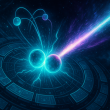Proof that cold fusion is real, and that it is nuclear fusion
While many aspects of cold fusion are unclear, two things about it are certain:
- It is nuclear fusion, and not a chemical reaction or any other nuclear process.
- It is a real effect, not an experimental error.
Skeptics often dispute these two assertions. This section summarizes the proof of them.
We know cold fusion is nuclear fusion because it produces excess heat with no chemical fuel, no chemical changes, at levels far beyond the limits of chemistry. There is only a tiny amount of chemical fuel in some cold fusion cells, enough to last a few seconds, yet cold fusion reactions usually continue for weeks, and sometimes months.
We know this is fusion, combining hydrogen isotopes to form helium and possibly other elements. When the fuel in the cell is heavy hydrogen (deuterium) reacting with palladium as the catalyst, the reaction converts deuterium into helium. It produces heat in the same ratio as one form of deuterium-deuterium (D-D) plasma fusion. Cold fusion also produces x-rays, and sometimes tritium, which can only come from a nuclear reaction.
Cold fusion starts with the same fuel as plasma fusion, and it produces the same product with the same energy ratio. But unlike plasma fusion, it does not produce a deadly flux of neutrons. It must have a different path, with different intermediate products. This resembles fire and metabolism. Both combine carbon and oxygen to make carbon dioxide, producing the same amount of heat (33 kJ/g of carbon). Fire directly combines carbon and oxygen, with no intermediate products. Metabolism is slow, with low heat output and many intermediate products with other elements such as hydrogen and nitrogen. But it is fundamental to thermodynamics that when two reactions begin with one material and end with another, even when the intermediate steps and materials are different, total heat production is the same. This is true of both chemical and nuclear reactions.
Why we know cold fusion is real
We know that cold fusion is real because the heat and tritium have been widely replicated, often at high signal to noise ratios. Excess heat has been reported by 180 laboratories. [Storms book] The correlation of helium to heat has been less widely replicated, because it is difficult to do, but it has been confirmed in seven laboratories, starting with China Lake and including SRI and the ENEA (Storms, Table 1, https://lenr-canr.org/acrobat/StormsEthepresenta.pdf)
Excess heat has sometimes been reported at low levels close to the margin of error, which means the results might be an experimental error. For example, the heat might be 50 mW in a calorimeter that cannot measure any less than 10 mW. However, in other cases the excess heat far exceeds the noise level of the instrument. For example, in calorimeters that can measure a fraction of 1 W, reactions as high as 101 W have been measured lasting continuously for 30 days. [Roulette et al.] Any laboratory calorimeter can measure 1 W or more with confidence. Storms reviewed 124 tests and found 90 that produced more than 1 W. (https://lenr-canr.org/wordpress/wp-content/uploads/StormsPeakheat124tests.jpg)
In experimental science, a result that has been widely replicated at high signal to noise ratios is true. There is no other standard of truth. If the result conflicts with theory, that can only mean the theory is wrong or inapplicable. That is the bedrock basis of the scientific method. Marginal results that have been measured in one or two labs might be wrong, but widely replicated results cannot be.
Skeptical doubts
Skeptics have proposed many hypotheses attempting to explain why the excess heat is not real. For example, they say the energy might be stored during an endothermic phase, and then released during an exothermic phase. This is incorrect. The data shows there are no endothermic phases. The endothermic phases would have to be equal to the exothermic ones; in other words, the output would have to dip below the zero line as much as it goes above. This does not happen.
Skeptical claims about cold fusion are notably lacking in rigor. For example, in the 2004 DoE review, while 6 of the panel members thought that cold fusion is real and should be funded, 11 others expressed doubts or had no opinion. Their views violated the scientific method in various ways, mainly by claiming that theory trumps experimentally proven facts. See: https://www.lenr-canr.org/acrobat/RothwellJresponsest.pdf


